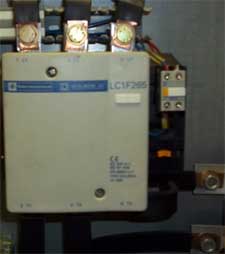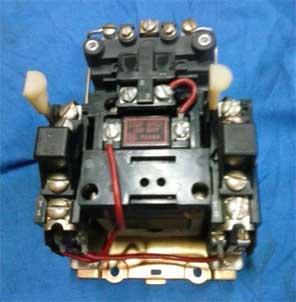Contactor Troubleshooting Guide
This contactor troubleshooting guide is provided with no warranty and is for entertainment purposes only. It is, however, considered a great place to start for a novice technician, maintenance person, or at-home troubleshooter.
A contactor is basically an electrically controlled switch. It is used to switch a separate power circuit, similar to a relay.
The difference being that the isolated secondary contacts have higher current ratings. A contactor is controlled by another circuit usually switched at a much lower power capacity.
The following article is a nice summary of contactor troubleshooting... There is always more conversation in our contactor forum.
OI is user supported. When you buy through our site, we may earn a small affiliate commission, our full disclosure is here.Basic Contactor Operation
In the world of manufacturing, whether it be heavy industrial or light production, wherever you find an electric motor there's always a contactor to drive and operate that motor. A contactor is simply an electrically controlled switch, also called a relay, used for switching a power circuit.
It is designed so that when sufficient current flows through a coil built into the contactor, the magnetic field which is generated causes the contacts to be pulled in.

The contacts, in turn operate as the switch. The contacts are appropriately sized by the designer of the particular circuit to handle current flow without overheating. Contactors are sold in a variety of sizes for specific applications.
The design of the contacts themselves permit the contactor to be opened and closed repeatedly with minimal damage. This, of course can and will vary depending on the load current and failure can come rather quickly to an improperly sized contactor.
Contactors are designed and built in two popular configurations, single phase (or single pole) and three phase (three pole). This designation merely signifies the number of circuits that can be operated simultaneously. The coil is the means of operating the contacts.
When it is energized with an appropriate voltage, it generates enough magnetic force to pull the contacts into a closed position, or close the power circuit.
When the coil circuit is opened, spring pressure returns the contacts into the open position threrefore opening the power circuit. Coils are usually designed to accept a variety of popular voltages including 12, 24, 120, 240, and 480 volts AC as well as some DC control voltages like 12 and 24 volts. Other non-standard or less popular voltages are available as well.
Typical Contactor Problems

The most common issue with a contactor, single or three phase would be a failed coil. This would cause the contactor to fail to energize when voltage is being applied to the coil. It can be tested in two ways, first in a power on situation, a check of the voltage at the coil terminals should give a definite answer as to whether the coil is energizing.
On contactors with overload resets you'll need to check the overload circuit of the contactor for failure or an open circuit if you do not read the appropriate voltage directly from the coil terminals.
Of course you will need to verify the voltage with the label or nameplate on the coil also. Any doubt as to your finding, you can check for coil continuity also. Be sure to power down the circuit (or the machinery if necessary), select a low ohms setting on your multimeter and check the coil terminals.
An open circuit (or high resistance) would signify an open coil whereas any moderate resistance would usually indicate that the coil is conducting electricity. A reading of 0 ohms would indicate a short circuit within the coil but this is rare because energizing a shorted coil usually amounts to excess heat, excess current, and an eventual opening of the coil internally.
The next most common failure is in the contacts themselves. They can fail in an open position, literally burned or melted open as a result of the contactor being improperly sized or the aftermath of a shorted load such as an overloaded motor.
[an error occurred while processing this directive]This can be tested by powering down the contactor circuit, both control and power circuit, and removing the power leads from the load side of the contactor. Energize the coil control circuit and check for the appropriate voltage on the load terminals.
Proper voltage going into the contactor and lack of voltage going out of the contactor while it is energized or closed is a classic case of a failed contact.
Another failure to the contacts would be a welded, or stuck contact which remains closed even when the contactor is de-energized. This situation can lead to further problems or damage downstream in the circuit possibly by energizing one or two legs of a three phase motor.
With the control and power circuit de-energized this can be checked with an ohmmeter set on any range. A low ohm or 0 ohm reading would indicate a closed contact when in fact it should be open.
Additional contactor problems include mechanical failure such as in the return springs or the frame of the contactor and most of the time a visual inspection is enough to find a problem such as this. These failures typically occur after excessive heating or after the operating or service life of the contactor has been exceeded.
Overall, the contactor troubleshooting is not complex, yet an overlooked failure within one of these critical components can sometimes confuse even a seasoned electrician or maintenance technician.
Classifieds
We also offer free industrial classified ad system complete with a category designed for want ads. We strongly encourage those with individual parts for sale, specifically new or vintage contactors, to list them at OI. Ad creation takes only a few minutes and is free of charge.
Those requiring an odd-ball part or obsolete component can place a want ad just as easily, again, with no fees associated with ads. The OI ad system is at your disposal... Place a want ad, list your individual parts for sale, or post a listing for your company here.
Search Classifieds →Automation, Electronics, & Industrial News
- How much per hour? Here's a cool salary wizard Free to use, search for industrial technician salary info near you. What are your salary expectations? Whether you are researching a new job offer, looking for a promotion, or just want to see what you should be getting paid as a technician.
- A Troubleshooter or Repairman... What is a Maintenance Technician? A maintenance technician will be involved in routine maintenance procedures as well as helping to troubleshoot problems should they arise with equipment in the manufacturing process, assisting in the installation of new manufacturing equipment, and calibration of equipment and routine inspection and testing of machinery. Read more...
- ABB launches IoT Dashboard IoT Dashboard for Commercial Building Automation ABB says its IoT Dashboard is "easy to commission, simple to install and intuitive to use", and allows better control, monitoring, and automation of any building functions.




